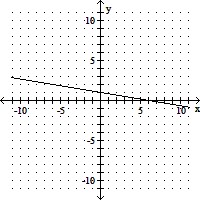Solve the problem.A defendant in a collision case claims that he was traveling at 36 miles per hour (which happens to be under the speed limit) around a blind curve and did not have time to swerve to miss rear-ending the plaintiff, who had just pulled into the road. The investigating officer determines that any speed less than 60 feet per second would have allowed time to brake or swerve to avoid the collision. How would you judge the defendant?
A. Not guilty. Because the defendant was traveling 64 ft./sec., he did not have enough time to stop.
B. Guilty. Because the defendant was traveling only 53 ft./sec., he should have had enough time to stop.
Answer: B
You might also like to view...
Solve the problem.A biologist collected 213 fern and moss samples. There were 157 more moss than fern samples. How many fern samples did the biologist collect?
A. 56 fern samples B. 185 fern samples C. 28 fern samples D. 171 fern samples
Use the given graph to find the x-intercept and the zero of the function.
A. (0, 0); 0 B. (1, 0); 1 C. (6, 1); 6 D. (6, 0); 6
Find an equivalent equation in rectangular coordinates.r =
A. y2 = 10x - 25 B. x2 = 10y - 25 C. y2 = 25 - 10x D. x2 = 25 - 10y
Find the x-value of all points where the function has relative extrema. Find the value(s) of any relative extrema.f(x) = x4/3 - x2/3
A. No relative extrema.
B. Relative maximum of 0 at 0; Relative minimum of -  at
at  and -
and - 
C. Relative maximum of 0 at 0; Relative maximum of -  at -
at - 
D. Relative minimum of of -  at
at 